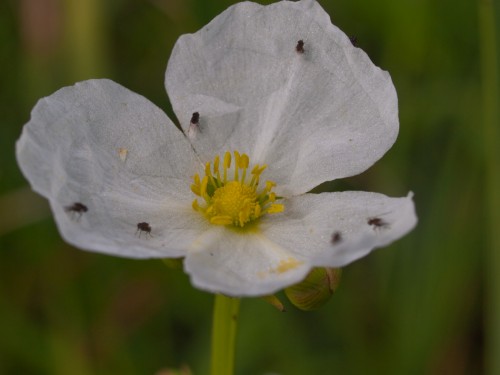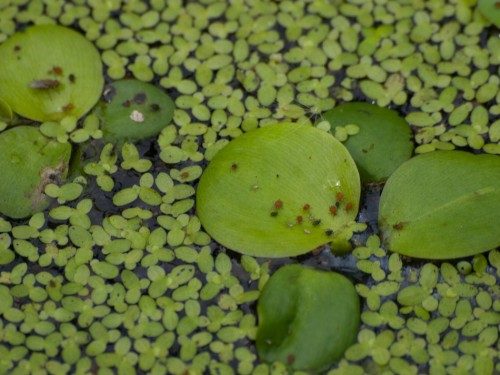Now there is plenty of Neptunia. I collected several bags for decomposition. The Neptunia appears to be reaching for the light.
Yesterday, I had the greatly appreciated help of several individuals that came along with the Tropical Biology OTS course. Pictured in the foreground are Abbie and Amanda, and in the background, Justin and Stevland. Not pictured is Mo Donnelly.
They fearlessly helped collect living Eichhornia at the crocodile-infested waters at the Catalina sector wetland for placement in competition enclosures in Palo Verde. The bags full of hyacinth are shown in the other picture.
Again, while photographing plants for a personal identification guide, I noticed there is much more going on in the photograph than plant identification.
I wonder what these flies are doing on this Echinodorus paniculatus flower. There is a pair for each petal; are they a breeding pair? If so, will they lay eggs and form a gull or otherwise use the Echinodorus has habitat/food? Are they simply attracted to the white?
In CSW, there is an abundant emergent macrophyte that I am unable to identify. It hasn’t flowered yet and the key in Crow’s Aquatic Plants of Palo Verde National Park and the Tempisque River Valley hasn’t been much help. If someone knows right away what this plant is, please let me know.
I’ve identified it to Thalia geniculata. Only the leaves are present currently.
Today (23 May), while wading though the wetland, I noticed that this plant has been hammered by herbivory (Figure 2 and 3). The nearly complete consumption of the leaves of this plant throughout the entire wetland appears to have been a result of a caterpillar (Figure 4 and 5).
When I downloaded this photograph, I noticed that there is alot going on in it.
I have taken a few photos of wetland plants for identification purposes, and I keyed this little floating plant (well, the larger one of the two…. I think the smaller one is either Lemna aequinactialis or Spirodela polyrhiza [Duckweed]) to Limnobium laevigatum. After I keyed it out, I noticed the aphids or other sucking bug, and then I noticed the fly in the upper left. It was hard enough to key the one plant out… now I have two plants in one picture, potentially competing, a herbivore concentrated on one plant, and another spectating insect that could itself and/or its larva be a predator on the herbivore!